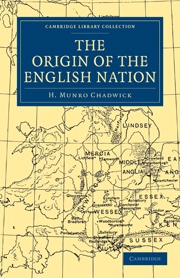Book contents
- Frontmatter
- PREFACE
- Contents
- CHAPTER I ENGLAND IN THE SIXTH CENTURY
- CHAPTER II THE WEST SAXON INVASION
- CHAPTER III THE INVASION OF KENT
- CHAPTER IV THE SAXONS, ANGLES AND JUTES IN BRITAIN
- CHAPTER V THE SAXONS, ANGLES AND JUTES ON THE CONTINENT
- CHAPTER VI THE KINGS OF ANGEL
- NOTE. THE EARLY KINGS OF THE DANES
- CHAPTER VII THE AGE OF NATIONAL MIGRATIONS
- CHAPTER VIII THE SAXONS AND ANGLES IN ROMAN TIMES
- CHAPTER IX THE CLASSIFICATION OF THE ANCIENT GERMANI
- CHAPTER X THE CULT OF NERTHUS
- CHAPTER XI KING AETHELWULF'S MYTHICAL ANCESTORS
- CHAPTER XII SOCIAL CONDITIONS OF THE ROMAN PERIOD
- ADDENDA
- INDEX
- Plate section
CHAPTER IX - THE CLASSIFICATION OF THE ANCIENT GERMANI
Published online by Cambridge University Press: 07 September 2010
- Frontmatter
- PREFACE
- Contents
- CHAPTER I ENGLAND IN THE SIXTH CENTURY
- CHAPTER II THE WEST SAXON INVASION
- CHAPTER III THE INVASION OF KENT
- CHAPTER IV THE SAXONS, ANGLES AND JUTES IN BRITAIN
- CHAPTER V THE SAXONS, ANGLES AND JUTES ON THE CONTINENT
- CHAPTER VI THE KINGS OF ANGEL
- NOTE. THE EARLY KINGS OF THE DANES
- CHAPTER VII THE AGE OF NATIONAL MIGRATIONS
- CHAPTER VIII THE SAXONS AND ANGLES IN ROMAN TIMES
- CHAPTER IX THE CLASSIFICATION OF THE ANCIENT GERMANI
- CHAPTER X THE CULT OF NERTHUS
- CHAPTER XI KING AETHELWULF'S MYTHICAL ANCESTORS
- CHAPTER XII SOCIAL CONDITIONS OF THE ROMAN PERIOD
- ADDENDA
- INDEX
- Plate section
Summary
In the last chapter mention was made incidentally of a passage in Pliny's Natural History, iv. 99, in which the Germani are classified in five large groups. It will be convenient here to give this passage in full: “There are five groups of the Germani; the Vandili to whom belong the Burgundians, the Varini, the …… and the Goths; the second group are the Inguaeones, to whom belong the Cimbri, the Teutoni and the nations of the Chauci; next to the Rhine are the Istaeuones (Istriaeones), to whom belong……; in the interior the Hermiones to whom belong the Suebi, the Hermunduri, the Chatti and the Cherusci. The fifth group consists of the Peucini, the Basternae conterminous with the above-mentioned Daci.” It is not quite clear whether in the last sentence Peucini is meant to be a group-name; but for our purpose this question is of no importance.
The other group-names all occur elsewhere. The name Inguaeones is mentioned again by Pliny himself (iv. 96). After a short description of the Scythian coasts (i.e. the eastern part of the Baltic) from north-east to south-west, he says: “At this point we get clearer information as we reach the nation of the Inguaeones, which is the first in Germany.” The Hermiones are mentioned again by Mela, De Chorographia, iii. 3, in his account of the Sinus Codanus “In it,” he says, “are the Cimbri and the Teutoni; beyond lie the Hermiones, the most remote of the Germani.” Lastly, Tacitus, Germ. 2, states that according to ancient native poems the whole race of the Germani was descended from the god Tuisto and his son Mannus.
- Type
- Chapter
- Information
- The Origin of the English Nation , pp. 195 - 219Publisher: Cambridge University PressPrint publication year: 2010First published in: 1924



